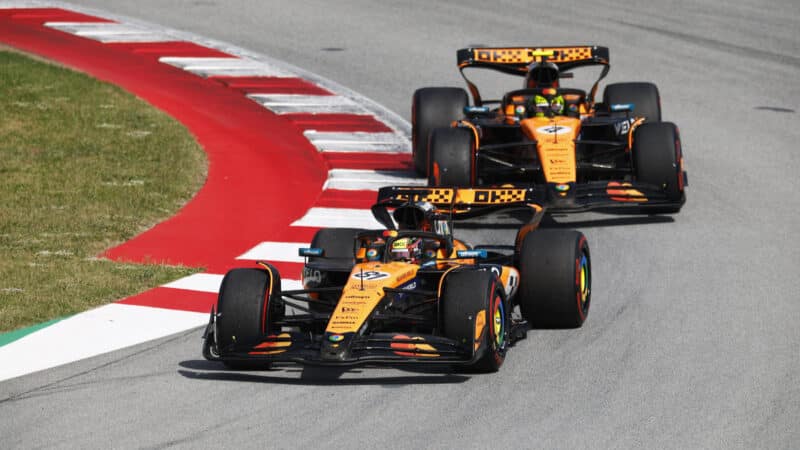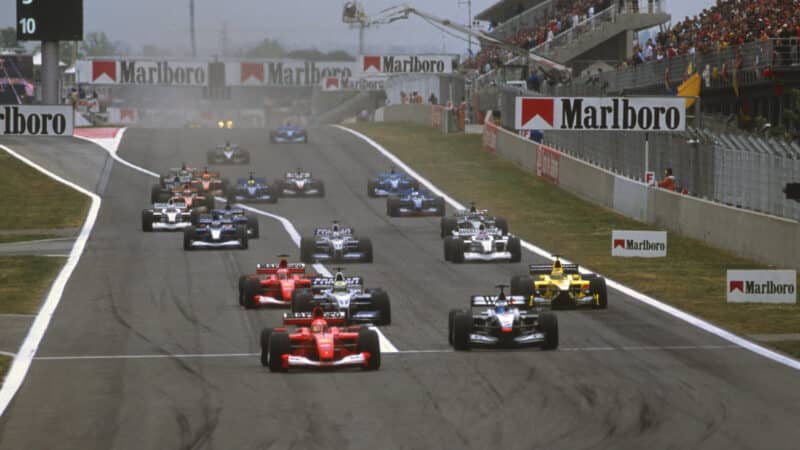Mark Hughes: Overhyped flexi-wing clampdown repeated a 2001 F1 story
Just like the much-anticipated traction control rule change in 2001, F1’s latest flexi-wing clampdown in Spain proved more hype than genuine shake-up, as Mark Hughes explains

If anything, McLaren looked even more competitive in Spain, despite rivals' hopes
McLaren
Even in the weeks leading up to the Spanish Grand Prix Red Bull had already begun rowing back a little on its early-season predictions that the new Technical Directive taking effect from Barcelona restricting the flexibility of the front wings would see a competitive reset. One where McLaren was no longer the dominant force.
Instead McLaren – with what was described as a ‘new wing hanger, costing about £50’ to meet the new stiffness requirements – sewed up the front row and scored its third 1-2 of the season. Red Bull, with a reprofiled front wing to optimise the airflow around the lesser degree of flex, qualified 0.4% adrift of pole compared to its seasonal average up to that point of 0.24% off.
Max Verstappen, despite a bold three-stop strategy that did concern McLaren for a while, was set to finish a distant third despite having delayed Lando Norris for the first 13 laps of the 66-lap race. That was before outside events involving race control and George Russell – two of his favourite triggers – saw Max lose emotional control. Competitively, his Spanish Grand Prix was fairly average by the standards of his season to date. Not disastrous, but there was certainly no evidence of the much-vaunted reset. At best, McLaren looked unaffected by the new restriction relative to the others. At worst, maybe even slightly more competitive.
As is invariably the case, the fastest car is so because of its combination of qualities, rather than some magic secret ingredient. Yes, McLaren was at the cutting edge of non-linear deformation and that certainly didn’t hurt its speed, but was it the silver bullet? No. McLaren team boss Andrea Stella had been saying for most of the season he was pleased the team’s rivals were focussing so hard on McLaren’s wings, as that was wasted energy not being spent on actually addressing their own shortcomings. Latterly of course those rivals have been focussing on McLaren’s rear brake ducts.

Red Bull has many times been in McLaren’s current situation of course. But when a bunch of intensely competitive people are tearing their hair out trying to understand where they are falling short, it’s understandable that paranoia and suspicion creep in.
Twenty-four years ago a very similar scenario unfolded around the same Barcelona track. Spain 2001 was the first race in which the traction control ban – in place since 1994 – was rescinded. The governing body had essentially given up on trying to police the ban, they said. But it was a little more involved than that.
Ferrari had been dominating the season with Michael Schumacher. The big buzz around Ferrari and Schumacher was that they were using the banned traction control – and had been for quite some time. At Interlagos, round 3 of the championship, Juan Pablo Montoya, racing his Williams-BMW up the hill side-by-side with Schumacher said he could actually hear it, the characteristic engine ‘misfire’ of the technology.

A traction control ban in Spain didn’t slow Ferrari
Grand Prix Photo
Except it wasn’t traction control. Not technically. Not according to the regulations of the time. The Ferrari’s software was anticipating imminent wheelspin and momentarily reducing the torque. It was not reacting to wheelspin. The difference was of course mere milliseconds, but one was legally okay, the other was not. Like this, Ferrari had been outsmarting the others.
The FIA had looked at it, had Ferrari explain how it worked, and had accepted that yes it was not technically traction control, even if the effect was much the same. It was therefore legal. Despairing of having to repeatedly judge if the wheelspin was being anticipated or reacted to and expecting everyone else to soon make the same step Ferrari had, the FIA decided it was easier all-round just to legalise traction control.
Williams’ Patrick Head was dismayed to find that at Barcelona, his cars were further behind Schumacher’s Ferrari than in any of the season’s preceding four races. Schumacher duly won the race from Williams’ Montoya by a margin of 40sec. The rivals had been looking in all the wrong places. There was no particular secret to the Ferrari F2001. It was a well-balanced car with good downforce, competitive power, tested extensively, well-understood and driven by Schumacher.

